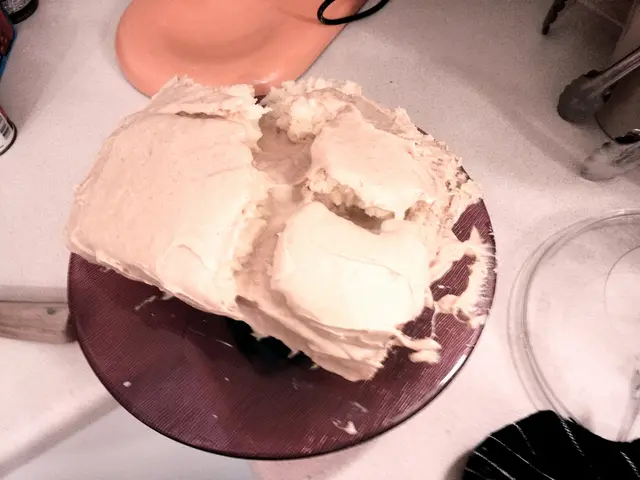Getting the Lowdown on Ringworm
Understanding Ringworm: A Detailed Look at This Common Skin Disease
While it may sound creepy, ringworm isn't actually caused by worms—it's a fungal infection. These nasty little critters love feasting on your skin, hair, and nails, making life miserable. Don't worry, you're not alone! Ringworm is highly contagious and can spread through direct contact with infected people, animals, or contaminated surfaces.
There are several types of ringworm, depending on the body part it attacks. When it strikes the scalp or beard, it's specifically referred to as ringworm of the scalp or beard. This bad boy can be a real pain, especially for kids, but don't stress—with a little know-how, you can kick it to the curb.
Catching a Glimpse of Spread
Ringworm can easily travel by:
- Grabbing a Handshake: Touching an infected person or furry friend.
- Sharing is Caring (Too Much!): Passing around personal items like combs, hats, or towels.
- Getting Too Close for Comfort: Hanging out in public showers or swimming pools without proper footwear.
Understanding how ringworm makes its rounds is crucial for prevention. Stick to good hygiene practices and keep your personal items all to yourself.
Signs You've Got It Bad
The symptoms of ringworm on the scalp or beard can vary, but here are some common ones to look out for:
Oops, I Scratch Again
An itchy scalp or beard might be the first sign of infection.
Scales, Scales, Everywhere
Red, scaly patches might appear on the scalp or beard area. These patches often have a raised border.
Bye-Bye, Hair!
Hair loss in infected areas can lead to bald patches.
Flakes Away!
The skin may become flaky or develop crusty lesions.
When Things Go South
In some cases, ringworm can lead to more severe symptoms, like:
- Pus-filled blisters
- Mild fevers
- Swollen lymph nodes
If you notice any of these symptoms, it's essential to see a healthcare provider for an accurate diagnosis and treatment. Catching ringworm early can save you from a world of pain and prevent it from spreading to others.
When to Call a Pro
While many cases of ringworm can be treated at home, here are some instances when you should seek medical attention:
- Symptoms worsen or don't improve with over-the-counter treatments.
- Severe pain or swelling pops up.
- You suspect a secondary bacterial infection, such as increased redness or pus.
Stay informed and protect your health by checking out our platform AI for reliable health answers.
In short, keeping yourself educated about ringworm of the scalp or beard is vital for successful prevention and treatment. By identifying symptoms early and seeking professional care, you can tackle this fungal infection like a boss. Don't forget to maintain good hygiene and avoid close contact with infected individuals, 'cause that's just smart. 🌟
Understanding the Root Causes
Ringworm of the scalp or beard (also known as tinea capitis or tinea barbae) is caused by a group of fungi called dermatophytes. These tricky little guys love seeping into your skin, hair, and nails, especially in warm, moist conditions. Common dermatophytes responsible for ringworm include:
- Trichophyton tonsurans—Popular in scalp infections.
- Microsporum canis—Usually transmitted by cats and dogs.
- Trichophyton verrucosum—Often found in cattle and sometimes infects humans.
Direct Contact Can Lead to Troubles
Ringworm is incredibly contagious and can spread through:
- Touching the infected area
- Sharing personal items like combs, hats, or towels
- Close contact during sports or physical activities
Contaminated Environments Can Cause Infections
Fungi can lurk on surfaces and contaminate the environment, making it easy to pick up ringworm from places like:
- Public showers and swimming pools 🏊♂️
- Gym locker rooms
- Shared equipment in sports facilities
You're at Higher Risk—Know the Factors
While anyone can develop ringworm, certain factors can increase your chances of getting infected:
Age is a Factor
Kiddos are particularly susceptible to ringworm of the scalp due to their close contact with peers and pets. However, it can still happen to adults, especially those with weakened immune systems.
Ain't Nobody Got Time for a Weak Immune System
Individuals with compromised immune systems, like those living with HIV/AIDS, diabetes, or undergoing cancer treatment, are more likely to develop ringworm. A healthy immunity system is crucial for fighting off fungal infections.
Get Clean and Dry
Poor personal hygiene can contribute to the development of ringworm. Try to shower after working out or sweating, avoid sharing personal items, and keep your hair clean and dry.
Crowded Conditions = Higher Risks
Living in close quarters, such as dormitories or homeless shelters, can heighten the chance of ringworm transmission. It's essential to maintain cleanliness and steer clear of sharing personal items.
Fidos Can Spread Infections
Pets, especially cats and dogs, can be carriers of the fungi that cause ringworm. If you spot any signs of ringworm on your furry friends, such as hair loss or scaly patches, visit the vet right away! Regular grooming and veterinary check-ups can help keep your pets healthy and limit the risk of transmission.
Gear up with the knowledge on the causes and risk factors related to ringworm of the scalp or beard to take preventative actions, protect your loved ones, and kick that fungal infection to the curb! 🌟
Identifying the Infection for Better Treatment
Diagnosing ringworm of the scalp or beard can be a straightforward process, but sometimes requires a keen eye and some lab work:
Keep an Eye Out for Symptoms
The first step in diagnosing ringworm is recognizing its symptoms. Look for:
- Itchy Scalp or Beard: An often-unwelcome first sign of infection
- Red, Scaly Patches: These might appear on the scalp or beard area
- Balding Patches: Infected areas may experience hair loss
- Dark Spots: Sometimes, you might notice darker areas of skin where the infection is present
- Inflammation: The skin might become swollen and tender
Visit a Pro for Accurate Diagnosis
If you suspect you have ringworm, it's important to consult a healthcare professional for examination and possibly some tests. During the visit, the doctor may ask questions about your medical history and recent interactions with infected individuals or animals. Here are some tests that could confirm the diagnosis:
- Skin Scraping: A small sample of skin is taken and checked under a microscope for fungal elements
- Fungal Culture: This involves growing the fungus from a sample to identify the specific type of dermatophyte
- Wood's Lamp Examination: Some fungi will fluoresce under ultraviolet light, aiding in identification
Early and accurate diagnosis is essential for successful treatment and recovery. 🩺
Overcoming Ringworm with Treatment Options
Once diagnosed, it's time to tackle the fungal menace! Treatment typically involves antifungal medications, which can be administered topically or orally, depending on severity:
Go Topical!
For mild cases, topical antifungal creams or ointments might do the trick. These treatments are applied directly to the affected area and include popular choices like:
- Clotrimazole: An antifungal that helps eliminate fungal invaders.
- Terbinafine: Often used for skin infections and works by inhibiting fungal growth.
- Miconazole: Another effective option that disrupts fungal membranes.
Apply these treatments twice daily and follow your healthcare provider's instructions for best results.
Take it Oral
In more severe cases or when the infection affects the scalp, oral antifungal medications might be necessary. Common options include:
- Griseofulvin: Popular for treating scalp ringworm and works by inhibiting fungal growth.
- Terbinafine: In oral form, it can be effective for more extensive infections.
- Itraconazole: Useful for resistant cases and requires a prescription.
Oral medications typically require a longer treatment duration, often lasting several weeks to months, depending on the severity of the infection and response to treatment.
Keep It Homey
While you wait for the meds to kick in, try some home remedies to alleviate symptoms and promote healing:
- Keep it Clean and Dry: Fungi thrive in moist environments, so dryness is crucial.
- Avoid Sharing Personal Items: Prevent the spread of infection by steering clear of sharing combs, towels, or hats.
- Use Antifungal Shampoos: These help reduce fungal presence on the scalp and can be particularly helpful in cases of scalp ringworm.
While home remedies offer relief, they should not replace medical treatment. Consult with a healthcare provider before starting any new treatment regimen. Keep calm and kick the ringworm to the curb! 🌟
Practical Home Remedies for Ringworm
Not ready to roll up to a healthcare professional just yet? Try out these DIY home remedies to help alleviate symptoms and support recovery:
1. Tea Tree Magic
Tea tree oil is popular for its antifungal properties. To use it:
- Mix a few drops of tea tree oil with a carrier oil, like coconut or olive oil.
- Apply the mixture to the infected area two times daily.
This blend helps reduce inflammation and battle fungal infections.
2. The Apple Cider Vinegar Secret
Apple cider vinegar (ACV) is another powerful remedy, thanks to its antifungal and antibacterial properties. Here's how to use it:
- Mix equal parts of ACV and water.
- Soak a cotton ball in the solution and apply it to the affected area for about 30 minutes.
Repeat daily for best results.
3. Garlic, the Powerhouse Antifungal
Garlic isn't just tasty—it's also a potent antifungal agent! To use garlic, create a paste with coconut oil:
- Mash a few cloves of garlic to create a paste.
- Apply the paste directly to the affected area and cover with a bandage.
- Leave it on for a few hours before rinsing off the paste.
Garlic can help halt fungal growth and promote healing.
4. The Soothing Properties of Coconut Oil
Coconut oil is both a moisturizer and a fungus-fighter! Apply plenty of virgin coconut oil to the affected area several times a day to help combat the outbreak.
5. Aloe Vera—Nature's Antifungal
Aloe vera soothes irritated skin and has antifungal properties. To use aloe vera:
- Apply fresh aloe vera gel to the infected area.
- Let it sit for at least 30 minutes before rinsing off.
This can offer relief and aid in the healing process.
While home remedies can help alleviate symptoms, they should not replace medical treatment. If the infection fails to improve, consult a healthcare professional to get proper treatment and guidance. 🌿
Stay Vigilant—Preventing Ringworm Infections
Stopping ringworm before it starts is important, especially if you've had a previous infection or fall into a high-risk category. Here are some practical prevention strategies:
1. Shedding Good Hygiene Habits
Keeping your skin clean and dry is a key step in preventing ringworm:
- Regularly wash the affected area with mild soap and water.
- Dry the area thoroughly, especially in humid weather.
2. Mind Your P's and Q's with Personal Items
Ringworm can spread through direct contact or sharing personal items. Remember:
- Avoid sharing combs, hats, or towels.
- Use your own sports gear and headgear.
3. Dress Appropriately
Wearing breathable clothing can help keep your skin dry and unfriendly to fungi. Keep these tips in mind:
- Opt for loose-fitting, natural fiber clothing like cotton.
- Steer clear of tight, synthetic clothing that can trap moisture.
4. Pet Care is Key
Pets can carry ringworm and transmit it to you. Take these precautions to keep your furry friends healthy and yourself free of ringworm:
- If your pet shows signs of infection, like hair loss or scaly patches, take them to the vet for a check-up and treatment.
- Keep your pet's living area clean and disinfected.
5. Sweep and Sanitize Shared Spaces
Fungal spores can linger in shared spaces, so it's essential to keep these areas clean:
- Regularly disinfect surfaces in communal areas such as gyms and locker rooms.
- Use antifungal sprays or wipes on shared equipment.
With these prevention tips, you can protect yourself from ringworm and ensure fungal infections remain a distant memory. Fight the good fight and stay healthy! 🏜️
FAQs—Ringworm of the Scalp or Beard
1. What exactly is Ringworm of the Scalp or Beard?
Ringworm of the Scalp or Beard is a fungal infection that affects the skin, hair, and nails on your head or beard. It can cause itching, scaly patches, hair loss, and sometimes, serious symptoms depending on the severity and body part affected.
2. How is Ringworm of the Scalp or Beard transmitted?
Ringworm of the Scalp or Beard can be transmitted through direct contact with an infected person or animal, or through contaminated objects and surfaces. It's also common to pick up the infection from shared items like combs, hats, or towels.
3. What symptoms should I look for?
Common symptoms of Ringworm of the Scalp or Beard include itching, redness, and scaly patches on the scalp or beard area. In more advanced cases, there might be hair loss, crusty lesions, pus-filled blisters, fever, and swollen lymph nodes.
4. How is Ringworm of the Scalp or Beard diagnosed?
A healthcare professional can diagnose Ringworm of the Scalp or Beard by examining the affected area, testing your hair or skin samples, and analyzing the fungi culture. In some cases, a Wood's lamp examination might be performed to visualize the fungal infection under UV light.
5. What treatment options are available?
Treatment for Ringworm of the Scalp or Beard usually involves antifungal medications, which can be administered topically or orally. Home remedies, like tea tree oil, apple cider vinegar, garlic, coconut oil, and aloe vera, can also help alleviate symptoms and promote healing.
6. Can Ringworm of the Scalp or Beard be prevented?
Yes, you can take preventive measures to minimize your risk of getting Ringworm of the Scalp or Beard: maintain good hygiene, avoid sharing personal items, keep your hair clean and dry, fido-proof your pet's living area, and regularly clean shared spaces with disinfectants. If you do suspect an infection, consult a healthcare professional immediately for proper diagnosis and treatment. 🩺
- In the realm of health and wellness, understanding the impact of ringworm on skin conditions like dermatophytoses is crucial.
- With ringworm of the scalp or beard (tinea capitis and tinea barbae) being primarily caused by the dermatophytes Trichophyton tonsurans, Microsporum canis, and Trichophyton verrucosum, understanding common transmission routes such as direct contact and contaminated environments can help us take preventive measures.








